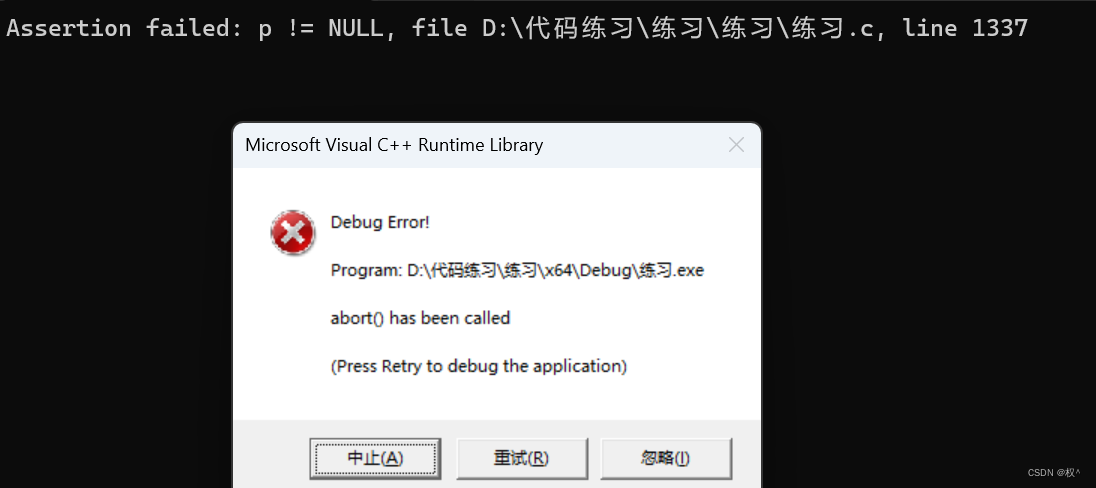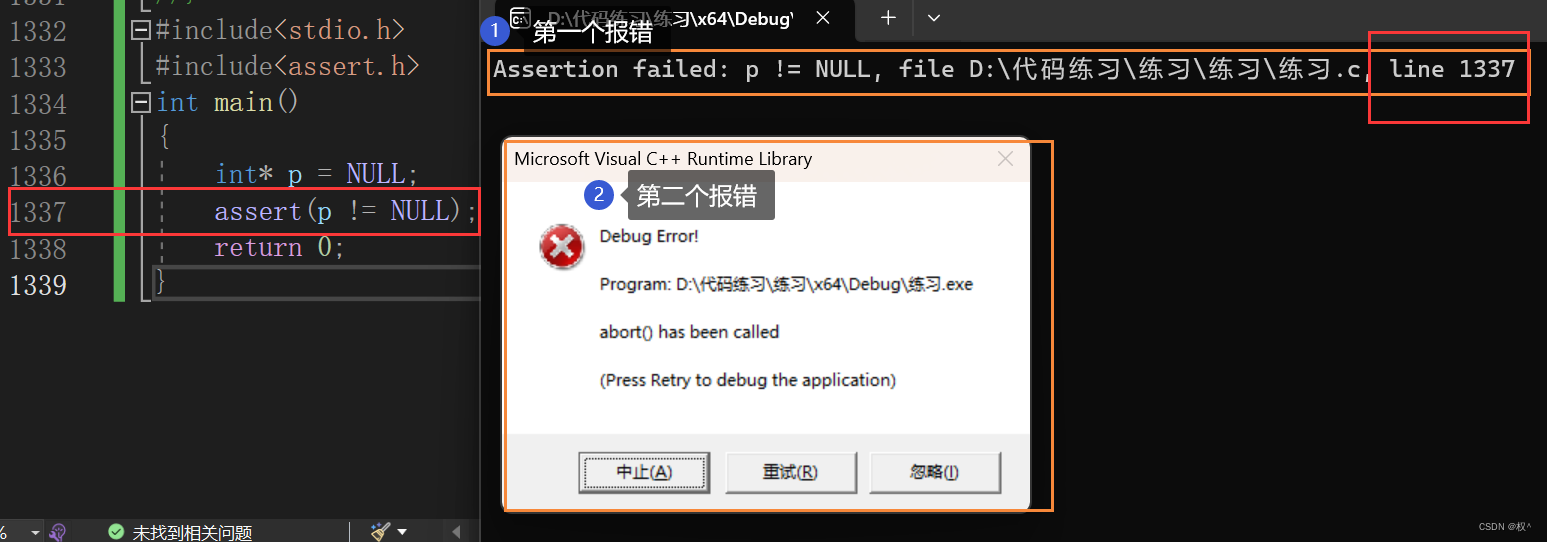目录
- 一、断言的概念
- 二、assert断言
- 2.1 代码1
- 2.1.1运行结果
- 2.1.2分析
- 2.2代码2
- 2.2.1运行结果
- 2.2.2分析
- 2.3代码3
- 2.3.1运行结果及其分析
- 三、优点
- 四、缺点
- 五、注意
一、断言的概念
assert.h 头⽂件定义了宏 assert() ,用于在运行时确保程序符合指定条件,如果不符合,就报错终止运行。这个宏常常被称为“断言”。
二、assert断言
assert(p != NULL);
上面代码在程序运行到这一行语句时,验证变量 p 是否等于 NULL 。如果确实不等于 NULL ,程序继续运行,否则就会终止运行,并且给出报错信息提升。assert() 宏接受⼀个表达式作为参数。如果该表达式为真(返回值非零),assert() 不会产⽣任何作用,程序继续运行。如果该表达式为假(返回值为零), assert() 就会报错,在标准错误流 stderr 中写⼊⼀条错误信息,显示没有通过的表达式,以及包含这个表达式的文件名和行号。
2.1 代码1
#include<stdio.h>
int main()
{int* p = NULL;assert(p != NULL);return 0;
}
2.1.1运行结果

这里显示assert未定义,需要包含头文件
#include<assert.h>
完整代码:
#include<stdio.h>
#include<assert.h>
int main()
{int* p = NULL;assert(p != NULL);return 0;
}
再次运行,运行结果:

2.1.2分析

报错会告诉你在哪一行。
2.2代码2
#include<stdio.h>
#include<assert.h>
int main()
{int a = 10;int* p = &a;assert(p != NULL);printf("%d", *p);return 0;
}
2.2.1运行结果

2.2.2分析
assert不等于 NULL ,程序继续运行,结果没有报错。
2.3代码3
#include<stdio.h>
#include<assert.h>
int main()
{int a = 0;scanf("%d", &a);assert(a>10);printf("%d", a);return 0;
}
2.3.1运行结果及其分析

三、优点
assert() 的使用对程序员是非常友好的,使用 assert() 有几个好处:它不仅能⾃动标识文件和出问题的行号,还有⼀种⽆需更改代码就能开启或关闭 assert() 的机制。如果已经确认程序没有问题,不需要再做断言,就在 #include <assert.h> 语句的前面,定义⼀个宏 NDEBUG 。
#define NDEBUG
#include <assert.h>
然后,重新编译程序,编译器就会禁用文件中所有的 assert() 语句。如果程序⼜出现问题,可以移除这条 #define NDBUG 指令(或者把它注释掉),再次编译,这样就重新启用了 assert() 语句。
代码:
#include<stdio.h>
#define NDEBUG
#include<assert.h>
int main()
{int a = 0;scanf("%d", &a);assert(a>10);printf("%d", a);return 0;
}
运行结果及其分析:

四、缺点
因为引⼊了额外的检查,增加了程序的运行的时间。
五、注意
一般我们可以在 Debug 中使用,在 Release 版本中选择禁用 assert 就行,在 VS 这样的集成开发环境中,在 Release 版本中,直接就是优化掉了。这样在debug版本写有利于程序员排查问题,在 Release 版本不影响用户使用时程序的效率。

)





)




求两个整数的平均值)



Java开发扩展之软件包与安装——JDK和MySQL)
【上】)

